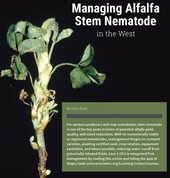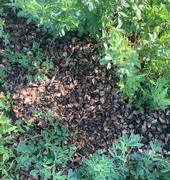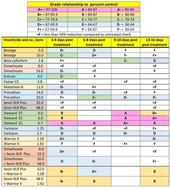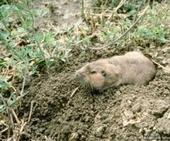- Author: Vicky Boyd
- Author: Rachael Long

This is a great article on Stem Nematode management in the West. Stem Nematode has been a severe pest in some years throughout California's Central Valley and high mountain valleys.
Stem nematode causes severe stunting, shortened internodes, and low first cut yields and can cause severe stand loss if infections are high. It's transferred by irrigation water and equipment. It is typically seen in very late winter or early spring.
Article by Ag Writer Vicky Boyd, in the Crops and Soils Magazine, available at:
- Author: Sarah E Light
- Author: Rachael Long
- Contributor: Taiyu Guan
- Contributor: Clair Akin

Background of the Project
Recent regulations, incentive funding, and the state's goal of reducing organic matter into the waste stream has led to increased organic matter application to California Farmland. With increasing limitations on burning orchard by-products, some alfalfa growers have been applying almond shell mulch to their fields.
Almond shells are distinct from almond hulls, which are high in carbohydrates and fed widely to livestock. Unlike hulls (which are more similar to dried peaches), shells are woody and break down more slowly. Almond shells are high in carbon and low in nitrogen (N).
- Author: Michael Rethwisch
- Editor: Ian M Grettenberger

This Grade Chart represents the average Insecticide Efficacy Grade against alfalfa weevil larvae from experiments conducted in the Palo Verde Valley over the past five years, with applications being approximately 18-20 gallons/acre to ensure excellent foliar coverage. Some products and rates are represented by only a single data point, while others have multiple year/rates of data. Data shown are from experiments which had weevil larvae numbers at or above economic threshold levels, providing high confidence in data.
Efficacy of pyrethroid insecticide products has changed through this period due to the development of insecticide resistance in this area's alfalfa weevils. Resistance has shifted multiple pyrethroids from...
- Author: Roger A Baldwin
- Author: Niamh Quinn
- Author: Daniel H. Putnam

PROPOSED LABEL CHANGES
The US EPA has proposed a series of dramatic changes to rodenticide labels which will significantly change how rodenticides are used in alfalfa, pasture, and many other crops (orchardes, vineyards).
Among other restrictions,
- All rodenticides for field applications will be restricted-use (new requirements for equipment, training)
- Above-ground applications eliminated
- Author: Rachael Freeman Long
- Author: Morgan Doran
- Author: Brooke Latack
- Author: Dan Putnam

Interest in integrating livestock and alfalfa production is on the rise in the U.S. as a way to produce more food per acre and improve farm income.
There are significant economic and environmental advantages to grazing, including lower costs, pest control, healthier animals, and soil health benefits. The main concerns or negatives may be bloat risk or hoof damage to alfalfa fields, but millions of acres of alfalfa and alfalfa-grass mixtures are grazed safely each year.
An Old Practice Becomes New: The practice of routinely grazing alfalfa and alfalfa-grass mixes is not new. It is a historical practice in the U.S., and in many parts of the world, grazing alfalfa and grasses is an...



